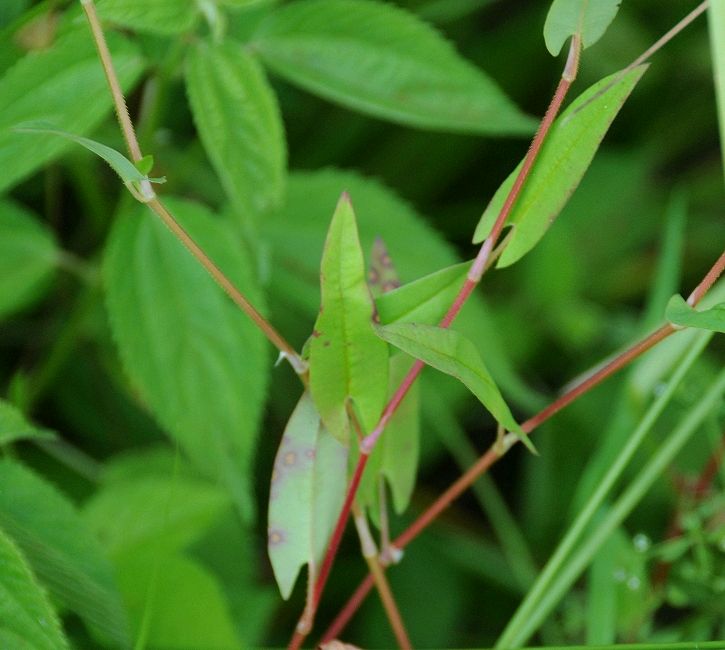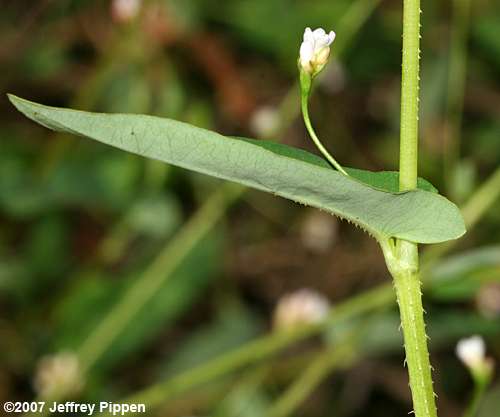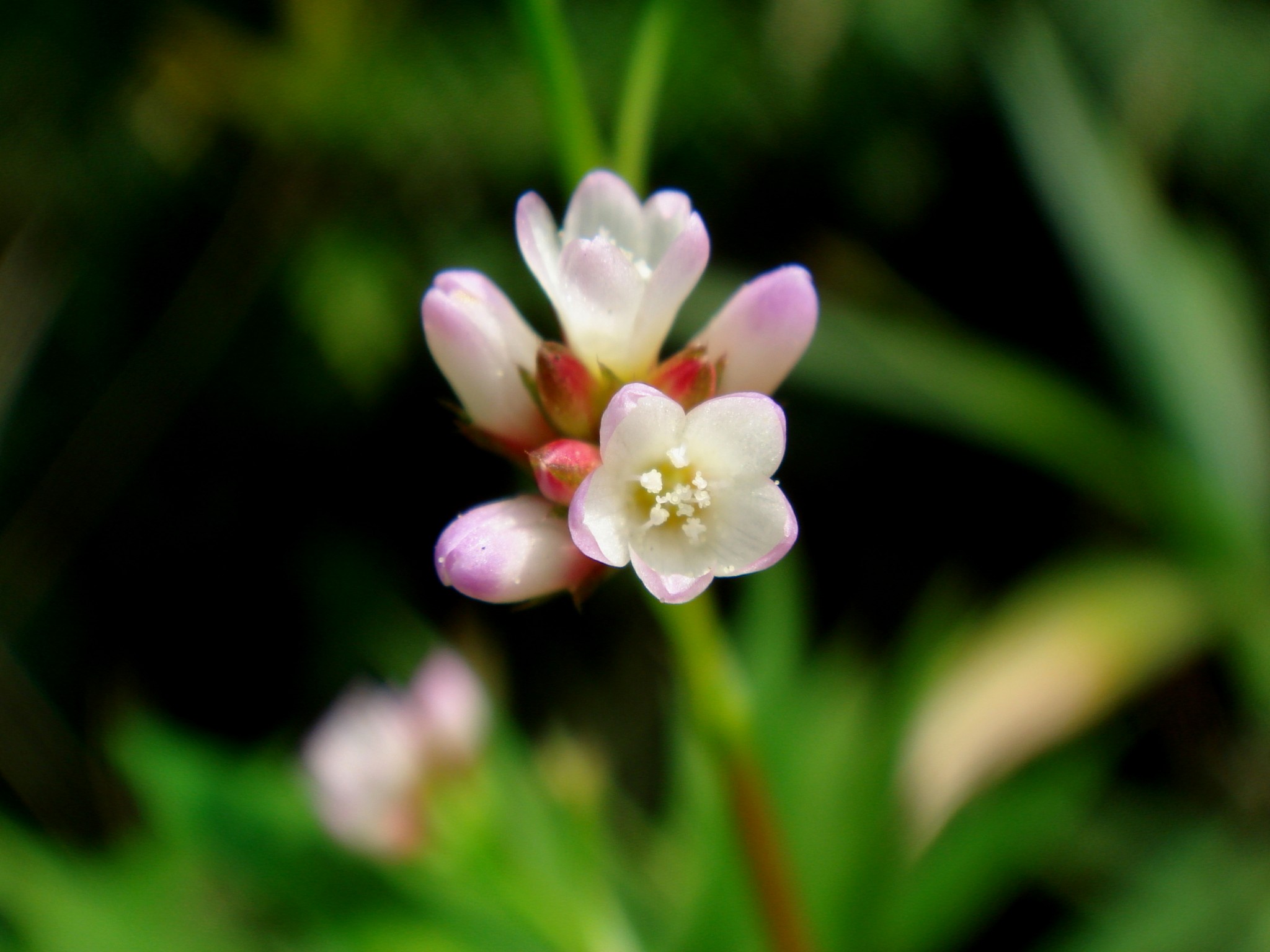 Download PDF
Download PDF
Name: Persicaria sagittata L.
Family: Polygonaceae, the Buckwheat Family
Common Names: Arrow-leaved tearthumb, arrow-vine, scratch-grass, gratte-cul, false buckwheat, American tear-thumb (1,7,11,13). 
Etymology: Persicaria comes from the Latin word persica, meaning “from Persia” or “peach-like”, and sagittata means “barbed, arrow-shaped” (1,8,15).
Botanical synonyms(2):
Polygonum sagittatum L. (accepted name under TROPICOS)
Polygonum sagittatum var. gracilentum Fernald
Tracaulon sagittatum (L.) Small
Truellum sagittatum (L.) Soják
Helxine sagittata (L.) Raf.
The following are synonyms of Polygonum sagittatum:
Persicaria sieboldii (Meisn.) Ohki
Polygonum belophyllum Litv.
Polygonum paludosum (Kom.) Kom.
Polygonum sieboldii Meisn.
Tracaulon sibiricum (Meisn.) Greene
Tracaulon sieboldii (Meisn.) Greene
Truellum sibiricum (Meisn.) Soják
Quick Notable Features (1,6):
¬ Four-angled stems bearing recurved prickles
¬ Simple, alternate sagittate leaves armed along the petiole and midrib
¬ Sheathing stipule (ocrea)
¬ Panicles of white to pink capitate flowers that produce 3-angled achenes
Plant Height: Arrow-vine grows up to 2m tall (16).
Subspecies/varieties recognized (2): Persicaria sagittata var. sieboldii (Meisn.) Nakai
Most Likely Confused with: Persicaria arifolia, Fallopia convolvulus, Fallopia cilinodis, Fallopia scandens, and Convolvulus arvensis (3).
Habitat Preference: P. sagittata prefers wet to moist habitats: bogs, marshes, fens, swamps, meadows, and along rivers and lakeshores (3,6,14).
Geographic Distribution in Michigan: The arrow-vine is found mostly in the southern half of the Lower Peninsula, and almost all of the Upper Peninsula (except Mackinac, Luce, and Dickinson counties) (3).
Known Elevational Distribution: P. sagittata grows at 1036m above sea level in North Carolina and 2200m above sea level in China (5,17).
Complete Geographic Distribution: Native to North America and East Asia. In the United States, the species is found in Oregon, Colorado, and every state east of Colorado. In Canada, it is found in Manitoba and every state east of it. P. sagittata is also present in China, Japan, S. Korea, Mongolia, Russian Federation, Nepal, India, Ireland, and Venezuela (2,4,5,13).
Vegetative Plant Description: The climbing stems of the annual herbaceous P. sagittata are glabrous, ribbed, 4-angled, with recurved prickles (1-1.5mm long). Young stems are light green to green, and may become red to purple as they mature. The nodes are sheathed by a papery ocrea (0.5-1.3cm long) that is apically round, unarmed, and glabrous, although it may bear marginal cilia up to 1mm long. The petiole (0.5-4cm) is armed with recurved prickles that continue along the midrib abaxially. The simple, alternate leaves are oblong to broadly-lanceolate, sagittate, the apices of the basal lobes parallel, 2-10cm long and 0.7-3cm broad, entire, and apically round to acute. The leaf blades often bear marginal cilia, and are glabrous to appressed-pubescent (1,3,6,10,14,17).
Climbing Mechanism: The arrow-vine climbs by leaning or scrambling on adjacent vegetation (1), which may be aided by the recurved prickles along the stems and petioles.

Flower Description: The inflorescences (3-15cm long) are axillary or terminal glabrous panicles, often branched and bearing minute recurved prickles near the base. They can be subtended by an ocrea-like bract (1.5-3mm long). Each inflorescence branch ends in a dense capitate cluster of fascicles, each ocreate fascicle bears 2-3 flowers. The peduncles are glabrous and 1-8cm long, and pedicels up to 1.5mm long. The 5 tepals are greenish to white and often tinged with red or pink, connate about half their length. Each tepal is broad elliptic, apically round, glabrous, and 0.3-0.5cm long. The eight stamens are epipetalous in 2 whorls: the outer five are 1-1.5mm long and the inner three are about 2mm long. The ovary is unilocular, superior, and topped by a 3-cleft style about 0.5mm long (1,6,16,17).
Flowering Time: Jun-Oct in North America (6).
Pollinator: The species is pollinated by insects, although nothing more specific was found in the literature (11,18).
Fruit Type and Description: The achenes are strongly 3-angled, 2.5-4mm long and 1.8-2.5mm broad, brown to black. Each bears a persistent style at the apex, and a surface that is smooth or punctate (1,6).
Seed Description: The seed is ruminate and the embryo curved, both common characteristics of the family Polygonaceae and of the genus Persicaria, respectively. The seeds have a higher germination rate during their first year, and an average weight of 6.4mg (6,10,19).
Dispersal Syndrome: There is no specialized mechanism for dispersal in P. sagittata, suggesting that the achenes are probably dispersed by gravity (19).
Distinguished by: Persicaria arifolia is very similar to P. sagittata, but leaves of the former are hastate, not sagittate, the inflorescences are short racemes bearing flowers with 4 tepals and 2-cleft styles, while P. sagittata bears elongated panicles with flowers of 5 tepals and 3-cleft styles. Additionally, the achene in P. arifolia is lenticular, not 3-angled. The stems and petioles in Fallopia convolvulus, F. cilinodis, F. scandens, and Convolvulus arvensis are unarmed. The leaves of F. convolvulus, F. cilinodis, and F. scandens are ovate-cordate. The inflorescence in F. convolvulus bears 2-4 flowers, and P. sagittata bears 2-3 flowers per fascicle. The base of the ocrea in F. cilinodis is barbed and the styles are free. F. scandens leaves may be slightly hastate, and the achenes are winged. C. arvensis stems are pubescent to glabrate, the inflorescence is solitary and the corolla is much larger (1.5-2cm long) than the small P. sagittata tepals. The fruit of C. arvensis is a capsule (1,3,6).
Other members of the family in Michigan (number species): Bistorta (1), Fagopyrum (1), Fallopia (5), Persicaria (13), Polygonella (1), Polygonum (6), Rheum (1), Rumex (13) (source 3).
Ethnobotanical Uses: P. sagittata is used as diuretic and helps to alleviate renal colic (11).
 Phylogenetic Information: The genus Persicaria is included in the tribe Persicarieae along with the genera Aconogonon, Koenigia, Rubrivena, and Bistorta, subfamily Polygonoideae in the Polygonaceae family. Recent molecular phylogenetic analysis has shown that the group Persicarieae is monophyletic, uniting most of the species formerly referred to as Polygonum with those in the genus Persicaria (20). The Polygonaceae is part of the order Caryophyllales, which contains approximately 6.3% of all known eudicots (9,10).
Phylogenetic Information: The genus Persicaria is included in the tribe Persicarieae along with the genera Aconogonon, Koenigia, Rubrivena, and Bistorta, subfamily Polygonoideae in the Polygonaceae family. Recent molecular phylogenetic analysis has shown that the group Persicarieae is monophyletic, uniting most of the species formerly referred to as Polygonum with those in the genus Persicaria (20). The Polygonaceae is part of the order Caryophyllales, which contains approximately 6.3% of all known eudicots (9,10).
Interesting Quotation or Other Interesting Factoid not inserted above: A paleobotanical study suggested that P. sagittata (listed as Polygonum sagittatum) from Arcto-Tertiary forests in North America and Asia has evolved very little and is extremely similar to the species today, along with other herbaceous species such as Cypripedium arietinum, Tovara viginica, and Brachyelytrum erectum (12).
Literature and websites used:
- Fernald, M.L. 1950. Gray’s Manual of Botany, 8th ed. New York: American Book Company.
- Tropicos.org. Missouri Botanical Garden. 31 Jan 2013 <http://www.tropicos.org/Name/50080889>
- Michigan Flora Online. A.A. Reznicek, E.G. Voss, & B.S. Walters. February 2011. University of Michigan. Web. January 31, 2013. http://michiganflora.net/species.aspx?id=2291.
- USDA, NRCS. 2013. The PLANTS Database, Version 3.1, National Plant Data Center, Baton Rouge, LA 70874-4490 USA. http://plants.usda.gov/java/profile?symbol=POSA5 Accessed January 31, 2013
- Gbif.org. Global Biodiversity Information Facility Website. Accessed: 31 January 2013.
- Hinds, H.H. & C.C. Freeman 2005. Flora of North America, Vol. 5: 32. Persicaria. http://www.efloras.org/florataxon.aspx?flora_id=1&taxon_id=242424265
- Radford, A.E., H.E. Ahles, & C.R. Bell 1968. Manual of the Vascular Flora of the Carolinas. Chapel Hill, NC: The University of North Carolina Press.
- Mahoney, K.D. 2002-2013. LatDict http://www.latin-dictionary.net/
- Sanchez, A., T.M. Schuster, J.M. Burke, & K.A. Kron 2011. Taxonomy of Polygonoideae (Polygonaceae): A new tribal classification. Taxon 60(1): 151-160.
- Stevens, P.F. (2001 onwards). Angiosperm Phylogeny Website. Version 12, July 2012 http://www.mobot.org/MOBOT/research/APweb/.
- Plants For A Future, 1996-2012. Accessed: 04 February 2013. http://www.pfaf.org/user/Plant.aspx?LatinName=Polygonum+sagittatum
- Stebbins, Jr., G.L. 1947. Evidence on rates of evolution from the distribution of existing and fossil plant species. Ecological Monographs 17(2): 149-158.
- Botanical Society of the British Isles and the Biological Records Centre. Online Atlas of the British and Irish Flora. http://www.brc.ac.uk/plantatlas/index.php?q=plant/persicaria-sagittata
- Rhoads, A.F. & T.A. Block 2007. The Plants of Pennsylvania: An Illustrated Manual. Philadelphia, PA: University of Pennsylvania Press.
- Black, M.R. & E.J. Judziewicz 2009. Wildflowers of Wisconsin and the Great Lakes Region: A Comprehensive Field Guide. Madison, WI: The University of Wisconsin Press.
- Stace, C. 1999. Field Flora of the British Isles. Cambridge, United Kingdom: Cambridge University Press.
- Anjen, L., A.E. Grabovskaya-Borodina, S. Hong, J. McNeill, H. Ohba, & C. Park 2004. Flora of China, Vol. 5: 2. Polygonum L. http://www.efloras.org/florataxon.aspx?flora_id=2&taxon_id=126398
- Wodehouse, R.P. 1931. Pollen grains in the identification and classification of plants VI. Polygonaceae. American Journal of Botany 18(9): 749-764.
- Clef, M.V. & E.W. Stiles 2001. Seed longevity in three pairs of native and non-native congeners: assessing invasive potential. Northeastern Naturalist 8(3): 301-310.
- Kim, S.-T. & M.J. Donoghue 2008. Molecular phylogeny of Persicaria (Persicarieae, Polygonaceae). Systematic Botany 33(1): 77-86.
Image Credits (all used with permission):
- Image of prickled leaves and stem courtesy of Glenn Galau, from http://wetlandbiology.net/plantimages/op/polpersag.htm
- Image of close-up leaf with inflorescence courtesy of Jeffrey S. Pippen, http://www.jeffpippen.com
- Image of flowers taken by Takato Natsu, a law professor of Meiji University, Tokyo, Japan, and used with permission from Prof. Summer’s Web Garden
- Image of achenes courtesy of Arieh Tal, from http://nttlphoto.com/botany/asters-goldenrods/a&g_main.htm.
- Species distribution map, derived from the Michigan Flora Online.
PRIMARY AUTHOR: Cristine V. Santanna with revisions and editing by John Bradtke and Robyn J. Burnham.
© Robyn J. Burnham
For additional information on Michigan Plant Diversity species accounts, please contact Robyn J. Burnham via email: rburnham“at”umich.edu